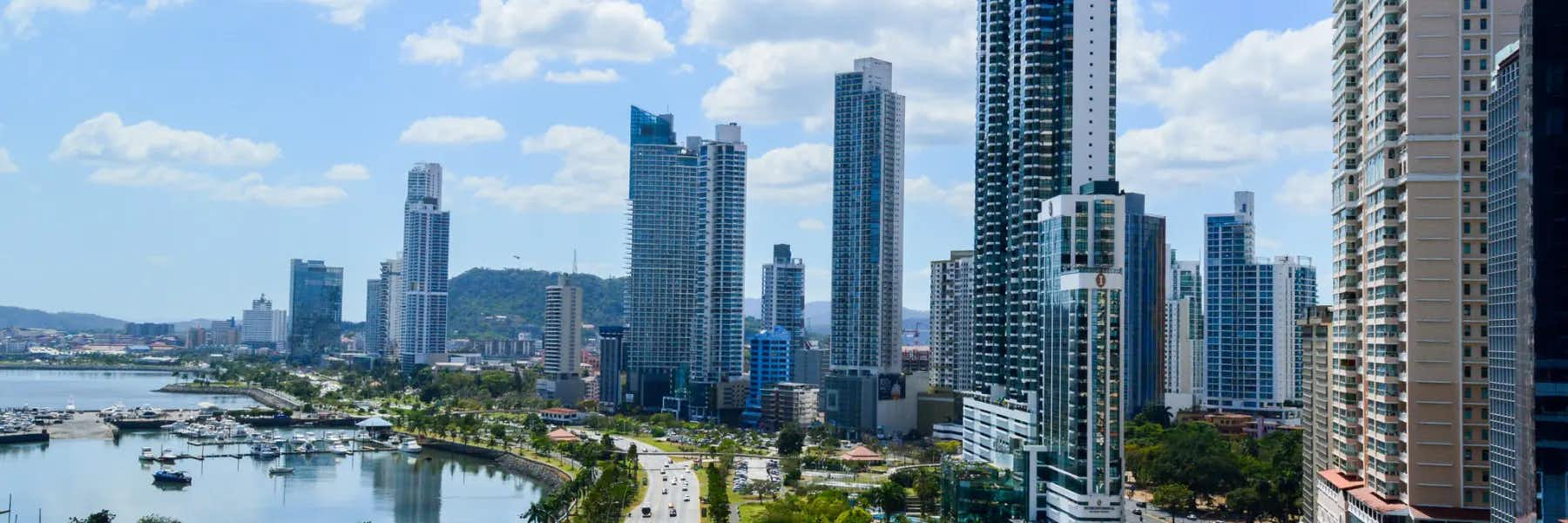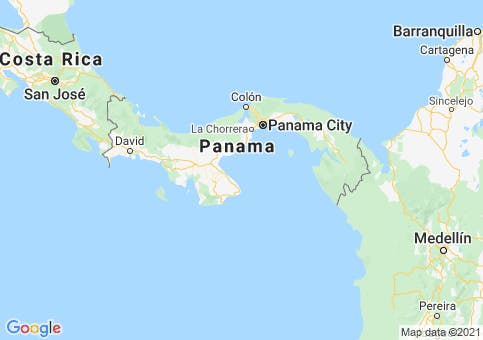By Jessica Ramesch
Panama’s reputation as an affordable retirement haven is well deserved. Take one look at the gleaming skyscrapers that define Panama City’s skyline, and you’ll wonder whether your plane landed in Miami by mistake. And yet—despite the apparent glitz and glamor—this is still one of the world’s top-value destinations.
This is true whether you choose the modern, international, oceanfront hub that is Panama City… the spectacular highlands with their cool breezes and sweeping mountain vistas… a coastal town with pristine beaches and sparkling turquoise waters… or rural farmland dotted with fruit trees, vegetable patches, and horse pastures.
Comparing the average cost of living in Panama with anywhere similar in the States, the difference is astounding. I’m talking good-weather locales with great beaches, no hurricanes, and lots of sunshine.
Video: What is the Cost of Living in Panama?
Rent/Buying
For example, how much would you pay for a 1,700-square-foot apartment in a nice town in California? Probably upwards of $400,000. In Coronado (one of Panama’s most desirable communities), I saw one listed for $185,000…
The apartment balcony overlooks a beautifully maintained golf course. The building has a gym, two pools, and a short drive from a pristine, uncrowded beach. There’s a doorman and security guard, and a concierge who will bring packages or ice right to your door. Oh, and the apartment is for sale fully furnished, and that’s thousands of dollars in major appliances and furniture.
Get Your Free Panama Report Today!
Get Your Free Panama Report Today!
Learn more about a healthier outdoor life in Panama and other countries in our daily postcard e-letter. Simply enter your email address below and we'll send you a FREE REPORT -- Panama: Easy, First-World Living and the World’s Best Retiree Program.

By submitting your email address, you will receive a free subscription to IL Postcards and special offers from International Living and our affiliates. You can unsubscribe at any time, and we encourage you to read more about our Privacy Policy.
Panama’s highland region offers incredible value for those who prefer mountains to beaches. A three-bedroom house was recently listed for $150,000 in the ultra-popular retirement haven of Boquete. Houses like it rent for as little as $800 a month, often including water and internet service.
Even in hip and happening Panama City, you can buy an apartment with an ocean view for as little as $165,000. I found one listed this week just a short walk from restaurants, the city’s bayside park and recreation belt, and a Johns Hopkin International affiliated hospital. Apartments for rent in Panama City’s upscale central areas start in the $900 to $1,500 range for 1,000+ square feet. And many come furnished. For perspective, median rents for two-bedrooms in San Diego are closer to $2,500.
Food/Groceries
Food—another major cost—is also more affordable in Panama. As a single living at the beach, I rarely spend more than $95 at the supermarket, even when I’m buying food for my pets and cleaning items.
Local produce is abundant and amazingly cheap. Sweet mango, papaya, pineapple…the local fruit selection is delectable, and there are also many imported items, like apples and grapes. To save on your monthly grocery bill, choose mostly local products and splurge on just a few imported items.
I started using local strawberries instead of blueberries in my pancakes. Instead of grabbing an apple on my way out the door, I grab a banana—just as portable and easy to consume. Often, when you’re out, you can buy cut fruit for a quick snack at street stalls or small shops. It’s faster than waiting in line at a drive-through, and it feels great to support local vendors instead of a mega-corporation.
On my last visit to a Rey supermarket—one of Panama’s best grocery store chains—I bought: frozen spinach, Gardein imitation chicken, premium coffee (Janson is my favorite Panamanian brand), six cans of Felix cat food, a dozen eggs, creamer, imported scamorza cheese (a big splurge at $8.60), tamarind paste, Maggi bouillon cubes, a small juice, three kinds of mushrooms (including a pack of portabellas), fresh green beans, tomatoes, potatoes, broccoli, watercress, lettuce, basil, limes, two bottles of Cirio tomato puree, Carefree pantyliners, Scott napkins, and Scott toilet paper for $93.58 total. Each purchase at the Rey earns me points, and I use them once or twice a year to buy around $10 worth of stuff.
If you’re big on couponing in the States, you’ll probably find that supermarket hauls cost you more in Panama—coupons aren’t really a thing here. But savings in other areas, especially taxes, healthcare, and insurance in Panama, will still put you ahead.
I eat out three or four times a month. Half the time I choose small eateries where I’ll spend $20 to $30. For example, my last outing was lunch at a tiny pizza joint called L’Altro Lato. I had a cappuccino and a personal pizza with a whole burrata on top for $17.12, and I had plenty left over for lunch the next day.
The other half of the time I splurge on pricey restaurants, spending as much as $70 in an evening. That usually includes a cocktail, a salad, a main dish (usually fish or seafood, which are excellent here), a couple glasses of wine with dinner, and a digestive or dessert after.
Transport/Utilities
I own a Hyundai Accent that I purchased and paid off here in Panama, so I mostly get around by driving. I typically spend less than $30 a month on gas, and my car insurance is just $58.32 a month. In Panama City, you can take the clean, new, air-conditioned metro across town for less than a dollar. Quick Uber rides in the city are often just $3 to $4. Outside of Panama City, yellow taxis and local buses are easy to use and I rarely spend more than a few dollars. And, of course, many expats choose to live in walkable central areas.
You’ll find that utilities in Panama are also reasonably priced. Power is my biggest expense—I use air conditioning day and night, but as long as I stay under 750 kilowatt hours of use, my bill is under $100 a month. Expats in mountain havens like Boquete find they spend far less, as they don’t need air conditioning or heating.
Get Your Free Panama Report Today!
Get Your Free Panama Report Today!
Learn more about a healthier outdoor life in Panama and other countries in our daily postcard e-letter. Simply enter your email address below and we'll send you a FREE REPORT -- Panama: Easy, First-World Living and the World’s Best Retiree Program.

By submitting your email address, you will receive a free subscription to IL Postcards and special offers from International Living and our affiliates. You can unsubscribe at any time, and we encourage you to read more about our Privacy Policy.
Water bills tend to be $10 to $30, though you’ll have water, gas, and trash collection included in your rent or condo maintenance fee in many buildings. My high-speed internet allows me to do my work as a writer and photographer (as well as stream shows on Netflix and the like) for $38 a month.
Healthcare Costs in Panama
And when it comes to healthcare, Panama is stellar. You can get health insurance for under $200 a month if you successfully apply before age 64. Even if you have zero insurance, doctor’s visits can cost as little as $20, with some services (like vaccines or minor wound care) offered for free or nominal fees of $2 to $5.
Every few months, one expat friend of mine goes to a private clinic to get the same 16 blood tests he used to get at Quest Labs in the U.S.: “Two big differences: Sixteen tests cost me $170 here, versus $1,257 in the U.S… and in Panama, my test results are emailed to me at the end of the next business day,” he says.
The breadth and quality of healthcare services in Panama have contributed more to my financial and emotional well-being than can be accounted for in terms of dollars spent. It’s about not having to stress about the uncertainties that lie ahead. What if one day I need major dental work that isn’t covered by my insurance? Back in the States, I’d sometimes lie awake at night, worrying. Here, I know I’ll be able to find affordable options.
After I moved to the upscale beach community of Coronado, I had a little tooth trouble. I quickly found several local dentists with excellent reputations among the expat crowd. One squeezed me in for a quick evaluation and then met with me later in the week.
On my first visit, he sat with me for a good 20 minutes, asking me (in English) about my life and any potential sources of stress. I paid nothing. On my second visit, we discussed the merits of a $700 crown versus a filling, and decided on the latter. I paid $100. This easy, unrushed approach is what sets Panamanian doctors apart from their U.S. counterparts.
Here’s some sample monthly budgets of what you could expect to pay on average in Panama:
A Budget for a Single-Person Household:
| Expense: | U.S. $ |
|---|---|
| Rent (furnished, one-bedroom home) | $600 to $1,500 |
| Electricity | $60 to $200 |
| Water (usually bundled with trash pickup) | $12 to $25 |
| Gas (for cooking, hot water heaters, dryer, etc.) | $0 to $10 |
| Household help (maid, three times a week) | $300 to $360 |
| Internet | $300 to $360 |
| Cellphone | $15 to $45 |
| Cable/Pay TV | $12 to $50 |
| Healthcare | $100 to $300 |
| Transportation (car maintenance/public transport) | $30 to $200 |
| Groceries | $30 to $200 |
| Entertainment (dining out and other activities) | $275 to $400 |
| Miscellaneous/Incidentals | $140 to $190 |
| Monthly Total: | $1,724 to $3,620 |
A Budget for a Two-Person Household in Panama:
| Expense: | U.S. $ |
|---|---|
| Rent (furnished, one-bedroom home) | $800 to $1,600 |
| Electricity | $60 to $200 |
| Water (usually bundled with trash pickup) | $12 to $25 |
| Gas (for cooking, hot water heaters, dryer, etc.) | $0 to $10 |
| Household help (maid, three times a week) | $300 to $360 |
| Internet | $30 to $40 |
| Cellphone | $15 to $45 |
| Cable/Pay TV | $12 to $50 |
| Healthcare | $200 to $500 |
| Transportation (car maintenance/public transport) | $50 to $200 |
| Groceries | $400 to $500 |
| Entertainment (dining out and other activities) | $250 to $350 |
| Miscellaneous/Incidentals | $150 to $250 |
| Monthly Total: | $2,279 to $4,130 |
Additional Costs to Consider
Like many expats, you may find it difficult to resist having a maid. It’s easy to find help in Panama, and you’ll likely pay $15 to $30 per visit. That generally includes cleaning the kitchen and bathrooms, sweeping and mopping the floors, and doing all the laundry.
Ironing is usually not included, but requesting some help with cooking or food prep is generally alright. Many expats find that one visit a week is plenty, whereas well-to-do Panamanian families tend to have full-time, live-in maids. (Salaries start at about $250 a month if room and board are provided.)
Get Your Free Panama Report Today!
Get Your Free Panama Report Today!
Learn more about a healthier outdoor life in Panama and other countries in our daily postcard e-letter. Simply enter your email address below and we'll send you a FREE REPORT -- Panama: Easy, First-World Living and the World’s Best Retiree Program.

By submitting your email address, you will receive a free subscription to IL Postcards and special offers from International Living and our affiliates. You can unsubscribe at any time, and we encourage you to read more about our Privacy Policy.
As if life in Panama doesn’t sound luxurious enough, and a lot cheaper than your current hometown, there’s one more thing you should know. In Panama, any retiree age resident—that’s age 60 for men, and 55 for women—is entitled to a host of special discounts.
Known as the pensionado discounts, these include 25% off power bills, 50% off movie and show tickets, 20% off medical consultations, 25% off meals at restaurants, and the list goes on. If you become a resident and are of age, you’ll pay just $3 on a $6 movie ticket… $13.50 on an $18 langoustine pasta dinner… and just $63 on a $90 round trip ferry ticket to the Pearl Islands.
To quote an expat friend who lives on one of Panama’s Caribbean islands…some things are too good to be true, and some are just truly good. And Panama’s low-cost, high-value amenities are among the latter. Even shopping for clothes is a joy here. There are more than a few local department store chains (my favorite is Saks) that sell irregular and unsold merchandise from the U.S. as well as inexpensive goods from the Latin America/Caribbean region and Asia.
During my last shopping spree at Saks I spent $109 on 20 items, including clothing, wireless headphones, sandalwood bath soaps, and a bag of chips. On the flip side, I do occasionally buy items from Amazon, and getting them shipped to Panama entails an extra expense. Like most expats here I use a courier service called Mailboxes, Etc., and have paid as much as $68 for a shipment.
I don’t need to buy things from Amazon…everything from power tools to golf equipment is available for sale right here in Panama. But sometimes I need an exact model or design only available on Amazon. It’s a luxury (and I’m grateful that my Panama lifestyle affords me many of those).
There are plenty of people who have moved to Panama in order to live simpler lifestyles. Folks who choose lesser-known destinations in Panama, where their dollars will stretch even further. Places where you can rent a house for $300 a month and see a doctor for $2. But most of us find that we don’t have to embrace minimalism here…not unless we want to.
True…you may need more than your social security to live comfortably in Panama’s most popular destinations. But if you’re looking for that California lifestyle—complete with great weather, beaches, food, and amenities—then Panama may be the best fit.
You know, without the California price tag.
Interested in learning more?
Panama’s myriad safe and attractive destinations are among the many worldwide havens featured every month in International Living magazine. If you are starting to think that Panama…or somewhere like it…might be right for you, then there’s no time like right now to subscribe.














